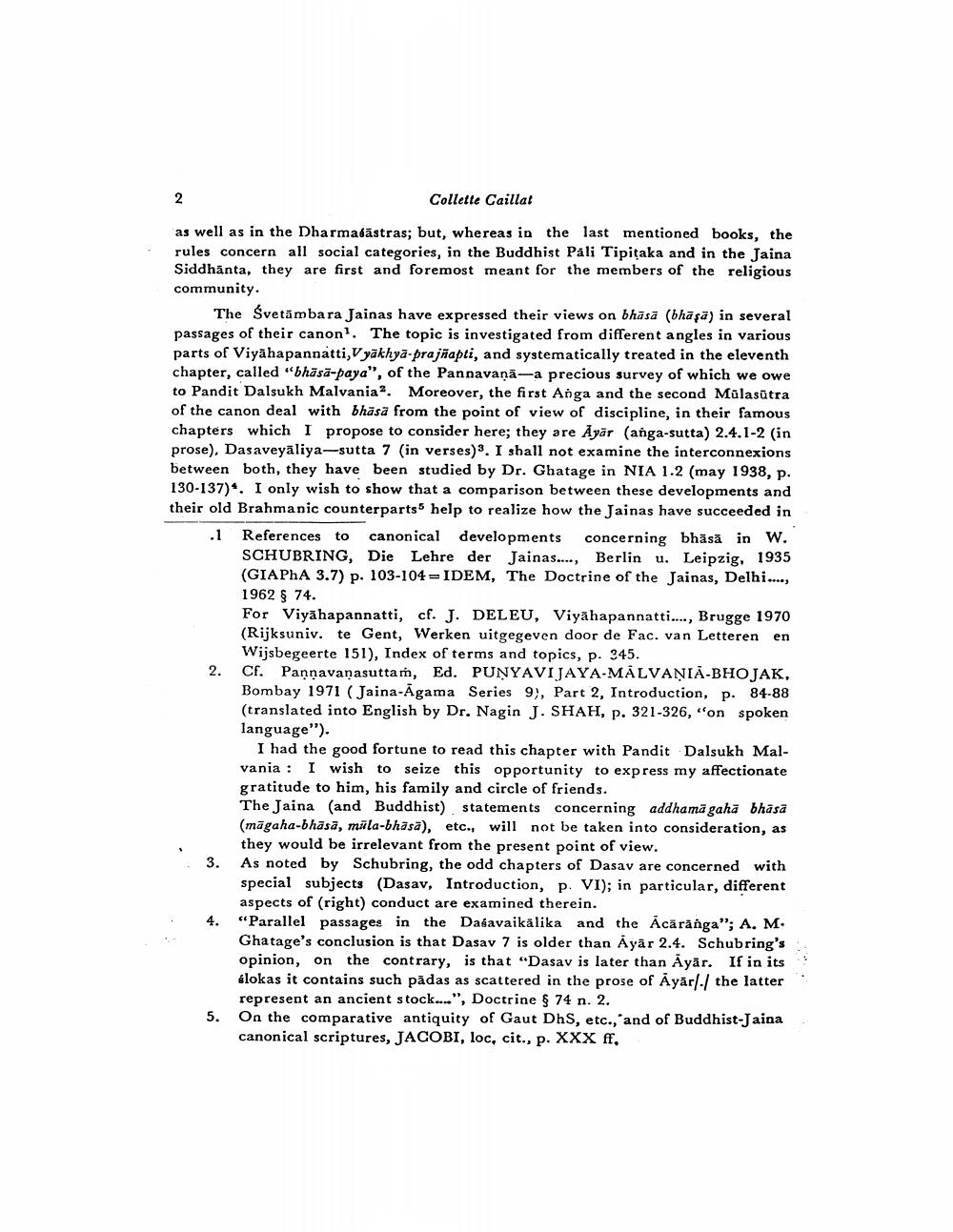Book Title: Rules Concerning Speech In Ayaranga And Dasaveyaliya Suttas Author(s): Collette Caillat Publisher: Collette Caillat View full book textPage 2
________________ Collette Caillat as well as in the Dharmaśāstras; but, whereas in the last mentioned books, the rules concern all social categories, in the Buddhist Pali Tipitaka and in the Jaina Siddhänta, they are first and foremost meant for the members of the religious community. The Svetambara Jainas have expressed their views on bhāsa (bhāsa) in several passages of their canon'. The topic is investigated from different angles in various parts of Viyahapannatti, Vyakhya-prajñapti, and systematically treated in the eleventh chapter, called "bhasa-paya", of the Pannavaņā-a precious survey of which we owe to Pandit Dalsukh Malvania. Moreover, the first Anga and the second Mülasūtra of the canon deal with bhāsa from the point of view of discipline, in their famous chapters which I propose to consider here; they are Ayar (anga-sutta) 2.4.1-2 (in prose), Dasaveyaliya--sutta 7 (in verses). I shall not examine the interconnexions between both, they have been studied by Dr. Ghatage in NIA 1.2 (may 1938, p. 130-137). I only wish to show that a comparison between these developments and their old Brahmanic counterparts help to realize how the Jainas have succeeded in .1 References to canonical developments concerning bhäsă in W. SCHUBRING, Die Lehre der Jainas...., Berlin u. Leipzig, 1935 (GIAPHA 3.7) p. 103-104 - IDEM, The Doctrine of the Jainas, Delhi...., 1962 $ 74. For Viyahapannatti, cf. J. DELEU, Viyahapannatti...., Brugge 1970 (Rijksuniv. te Gent, Werken uitgegeven door de Fac. van Letteren en Wijsbegeerte 151), Index of terms and topics, p. 345. Cf. Pannavanasuttam, Ed. PUNYAVIJAYA-MALVANIA-BHOJAK, Bombay 1971 (Jaina-Agama Series 9), Part 2, Introduction, p. 84-88 (translated into English by Dr. Nagin J. SHAH, p. 321-326,"on spoken language"). I had the good fortune to read this chapter with Pandit Dalsukh Malvania: I wish to seize this opportunity to express my affectionate gratitude to him, his family and circle of friends. The Jaina (and Buddhist) statements concerning addhamā gahābhāsā (māgaha-bhāsa, müla-bhāsā), etc., will not be taken into consideration, as they would be irrelevant from the present point of view. 3. As noted by Schubring, the odd chapters of Dasav are concerned with special subjects (Dasav, Introduction, p. VI); in particular, different aspects of (right) conduct are examined therein. "Parallel passages in the Dasavaikälika and the Acäränga"; A. M. Ghatage's conclusion is that Dasav 7 is older than Ayar 2.4. Schubring's opinion, on the contrary, is that "Dasav is later than Ayar. If in its blokas it contains such pädas as scattered in the prose of Ayarl-/ the latter represent an ancient stock...", Doctrine § 74 n. 2. On the comparative antiquity of Gaut DhS, etc., and of Buddhist-J aina canonical scriptures, JACOBI, loc. cit., p. XXX ff, 5.Page Navigation
1 2 3 4 5 6 7 8 9 10 11 12 13 14 15
